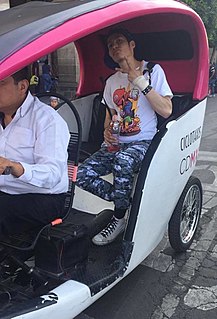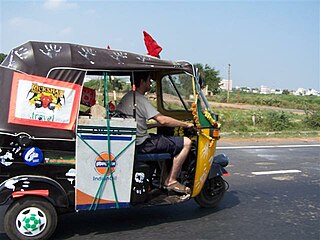 W
WA rickshaw originally denoted a two- or three-wheeled passenger cart, now known as a pulled rickshaw, which is generally pulled by one person carrying one passenger. The first known use of the term was in 1879. Over time, cycle rickshaws, auto rickshaws, and electric rickshaws were invented, and have replaced the original pulled rickshaws, with a few exceptions for their use in tourism.
 W
WAn auto rickshaw is a motorized version of the pulled rickshaw or cycle rickshaw. Most have three wheels and do not tilt. They are known by many terms in various countries including auto, auto rickshaw, baby taxi, mototaxi, pigeon, bajaj, chand gari, lapa, tuk-tuk, Keke-napep, Maruwa, 3wheel, pragya, bao-bao and tukxi.
 W
WNobo Kumar Bhadra is one of the known rickshaw painters of Bangladesh. Rickshaw paint is a traditional folk art of Bangladesh
 W
WThe cycle rickshaw is a small-scale local means of transport. It is a type of hatchback tricycle designed to carry passengers on a for-hire basis. It is also known by a variety of other names such as bike taxi, velotaxi, pedicab, bikecab, cyclo, beca, becak, trisikad, sikad, tricycle taxi, trishaw, or hatchback bike.
 W
WElectric rickshaws have been becoming more popular in some cities since 2008 as an alternative to auto rickshaws and pulled rickshaws because of their low fuel cost, and less human effort compared to pulled rickshaws. They are being widely accepted as an alternative to petrol/diesel/CNG auto rickshaws. They are three-wheelers powered by an electric motor ranging from 650 to 1400 Watts. They are mostly manufactured in India and China. Battery-run rickshaws could be a low-emitter complementary transport for the low-income people, who suffer most from a lack of transport facility, if introduced in a systematic manner according to experts.
 W
WMotorized tricycles, or simply tricycles, is a type of motorized vehicle from the Philippines consisting of a motorcycle attached to a passenger cab. Along with the jeepney, it is one of the most common means of public or private transportation in the Philippines, especially in rural areas. These public utility vehicles either ply a set route or are for-hire, like taxis.
 W
WPedal Me is an e-cargo bike logistics and pedicab company in London. The company was founded in 2017 by Benjamin Knowles, a transport planner, Chris Dixon and Rob Sargent. Pedal Me says that in Central London, it is cheaper and quicker than the taxi service Uber, although this advantage is lost further out from the city centre.
 W
WA pulled rickshaw is a mode of human-powered transport by which a runner draws a two-wheeled cart which seats one or two people.
 W
WRickshaw art or auto art is a form of neo-romanticism emerging in Bangladesh.
 W
WThe Rickshaw Run is an event where teams drive Auto Rickshaws along various routes across India. The first route in December 2006 was from Kochi, in the southern state of Kerala, to Darjeeling, in West Bengal. In its inaugural run, 34 teams started the event, and 31 of those finished. The rickshaw run has involved dangerous road incidents occurring during the 'race'.
 W
WRickshaws are used in numerous cities in the United States, primarily for their novelty value as an entertaining form of transportation for tourists and locals. However, they also have environmental benefits and may be quicker than other forms of transport if traffic congestion is high. Various laws regulate their use in different areas.
 W
WTuctuc Ltd was an auto rickshaw operator in Brighton, England. It operated for just over a year from the summer of 2006 until late 2007, but opposition from taxi operators and licence breaches "made the service unworkable" and the vehicles were withdrawn. In 2009 they were used again for weekend sightseeing tours of the city.